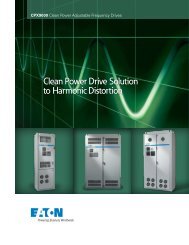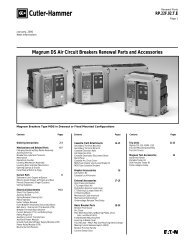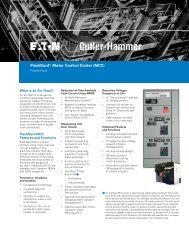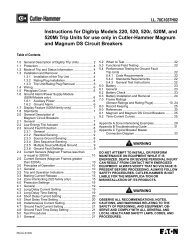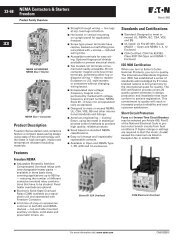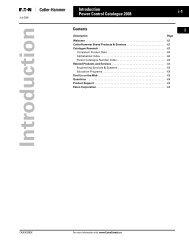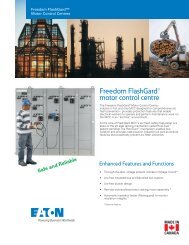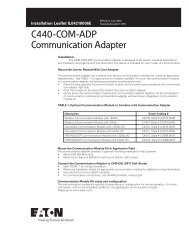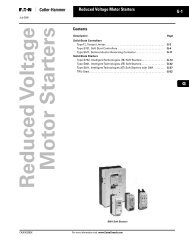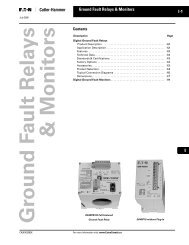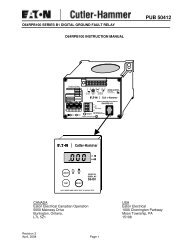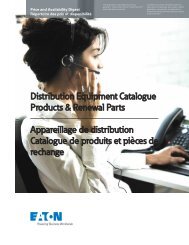molded case circuit breakers - Eaton Canada
molded case circuit breakers - Eaton Canada
molded case circuit breakers - Eaton Canada
Create successful ePaper yourself
Turn your PDF publications into a flip-book with our unique Google optimized e-Paper software.
PRODUCT DESCRIPTION<br />
Molded <strong>case</strong> <strong>circuit</strong> <strong>breakers</strong> are designed<br />
to provide <strong>circuit</strong> protection for low-voltage<br />
distribution systems. They are<br />
described by NEMA as,“. . . a device for<br />
closing and interrupting a <strong>circuit</strong><br />
between separable contacts under both<br />
normal and abnormal conditions,” and<br />
furthermore as,“. . . a breaker assembled<br />
as an integral unit in supporting an<br />
PRODUCT HISTORY<br />
Originally a Westinghouse Product<br />
The need for <strong>molded</strong> <strong>case</strong> <strong>circuit</strong> <strong>breakers</strong><br />
came about in 1918 when numerous<br />
applications for electrical motors resulted in<br />
a demand for a device that would ensure<br />
safe operation and, at the same time, protect<br />
electrical <strong>circuit</strong>s.<br />
During this period, individual motors were<br />
used for the first time in industrial plants to<br />
operate machine tools and in private homes<br />
to operate appliances. Plant electricians<br />
were constantly changing fuses blown during<br />
motor start-ups because of the lack of<br />
properly designed fuses for motor <strong>circuit</strong><br />
protection. Homes experienced similar<br />
problems when electrical <strong>circuit</strong>s were overloaded.<br />
Inspectors were concerned about<br />
fire hazards because of plug fuses being<br />
bridged with pennies and the installation of<br />
fuses with too high of an ampere rating.<br />
Inspection authorities became involved<br />
and attempted to find a solution to the<br />
problem. Meetings with switch manufacturers<br />
were initiated in an effort to find a<br />
MAJOR PRODUCT INTRODUCTION<br />
1923<br />
1927<br />
1939<br />
March 2001<br />
First compact, workable <strong>circuit</strong> breaker developed by Westinghouse<br />
enclosed housing of insulating material.”<br />
The NEC describes them as, “. . . a device<br />
designed to open and close a <strong>circuit</strong> by<br />
non-automatic means, and to open the<br />
<strong>circuit</strong> automatically on a predetermined<br />
overload of current, without injury to itself<br />
when properly applied within its rating.”<br />
Circuit <strong>breakers</strong> protect against overloads<br />
in conductors and protects against short<br />
solution. Switch manufacturers were<br />
asked to develop a switching device that<br />
would interrupt a <strong>circuit</strong> under prolonged<br />
overload conditions. The device would<br />
have to be safe, reliable and tamperproof.<br />
It should also be resettable so as to be<br />
reusable after an interruption without<br />
replacing any parts. This search for better<br />
<strong>circuit</strong> protection resulted in many different<br />
but unacceptable approaches to the<br />
problem. These early meetings and subsequent<br />
efforts prepared the groundwork<br />
for the eventual development of the <strong>molded</strong><br />
<strong>case</strong> <strong>circuit</strong> breaker.<br />
After intensive research and development,<br />
Westinghouse produced the<br />
DE-ION arc extinguisher for use in large<br />
oil <strong>circuit</strong> <strong>breakers</strong>. Although too large in<br />
its initial form to be practical for small<br />
<strong>circuit</strong> <strong>breakers</strong>, the arc extinguisher was<br />
eventually modified into a usable size. The<br />
first compact, workable <strong>circuit</strong><br />
breaker was developed in 1923 when the<br />
Westinghouse introduced the first complete <strong>circuit</strong> breaker line, rated 10-600<br />
amps, 600 volts<br />
Along with ordering information and style numbers, the various maximum current ratings<br />
came to be known by frame designations:<br />
50 Ampere E Frame<br />
100 Ampere F Frame (Non-interchangeable Trip)<br />
100 Ampere G Frame<br />
225 Ampere K Frame<br />
600 Ampere L Frame<br />
1970 Motor Circuit Protector (”MCP“) introduced – First sensitive, low level protection designed specifically for<br />
motor <strong>circuit</strong>s<br />
1973 ”SELTRONIC“ introduced – First <strong>molded</strong> <strong>case</strong> <strong>circuit</strong> breaker with an electronic trip unit<br />
1979 ”Current Limit-R Circuit Breaker“ introduced – First true current limiting <strong>circuit</strong> breaker<br />
1995 ”OPTIM“ Family introduced – First truly programmable <strong>molded</strong> <strong>case</strong> <strong>circuit</strong> breaker<br />
5<br />
<strong>circuit</strong>s in connected apparatus, such as<br />
motors and motor starters.<br />
Circuit <strong>breakers</strong> are designed for use in<br />
panelboards, switchboards, motor control<br />
centers, control panels, combination starters,<br />
individual enclosures, and bus duct<br />
plug-in units.<br />
modified arc extinguisher was coupled<br />
with a thermal tripping mechanism. It was<br />
not until four years later, however, that<br />
Westinghouse research engineers found<br />
the ideal combination of materials and<br />
design that permitted <strong>circuit</strong> <strong>breakers</strong> to<br />
interrupt fault currents of 5000 amperes<br />
at 120 volts AC or DC. One year later,<br />
Westinghouse placed the first <strong>circuit</strong><br />
breaker on the market. Its acceptance was<br />
instantaneous.<br />
Since that initial introduction in 1927,<br />
Westinghouse continued to be at the forefront<br />
of <strong>circuit</strong> breaker technology with an<br />
unprecedented series of <strong>circuit</strong> protective<br />
enhancements and introductions as<br />
chronicled below. In 1994 the <strong>Eaton</strong> Corporation,<br />
another World Class technology<br />
leader, acquired the Westinghouse Distribution<br />
and Control Business Unit and integrated<br />
it with Cutler-Hammer forming a<br />
powerful, new combination, poised to<br />
meet the challenges of the next 100 years.<br />
1920 1930 1940 1950 1960 1970 1980 1990 Present<br />
1982 ”Series C“ Family introduced – New World Class standard meeting increasing interrupting requirements without sacrificing<br />
compact size<br />
1994<br />
MOLDED CASE CIRCUIT BREAKERS<br />
Westinghouse Distribution and Control Business Unit (DCBU) acquired by <strong>Eaton</strong>, integrated with Cutler-Hammer<br />
(The Cutler-Hammer line of <strong>molded</strong> <strong>case</strong> <strong>circuit</strong> <strong>breakers</strong> was sold when merged with Westinghouse)<br />
A



